Holle Cropper Pigeon: Behavior And Breed Guide
Pouter pigeons are one of the most amazing of its species. Their rhythmically inflating and deflating globes create a rare sight. Among all breeds of pouters, the Holle Cropper Pigeon wins the most hearts for its incredible aesthetics and colors.
Pigeon enthusiasts breed the Holle Cropper for its perfectly rounded globes. It looks like a small ball standing on two feet when the pigeon is in full inflation.
They have a handsome forehead and a long sigmoid neck that moves with its prideful strut. It’s a historical breed that you can find in old Dutch paintings.
Anyone who fancies will love the Holle Cropper Pigeon. They are gentle and social with a strong personality. Learn more about this fascinating pigeon breed and how to raise them.
Holle Cropper Pigeon Profile
| Name | Holle Cropper Pigeon Features |
|---|---|
| Scientific Name | |
| Common Names | |
| Origin | |
| Size | |
| Weight | |
| Lifespan | |
| Physical Features | |
| Temperament | |
| Behavior | |
| Special Features | |
| Breeding and Maintenance | |
| Common or Popular Varieties |
Interested in similar topics on pigeon breed:
Overview Of Holle Cropper Pigeon
The Holle Cropper Pigeon is a small-sized pouter pigeon. It’s a popular fancy breed in the USA and other parts of the world.
In those areas, this pigeon is also known as the Boulant d’Amsterdam, the Amsterdamer Kröpfer, the Gozzuto in Amsterdam, and the Амстердамский дутыш.
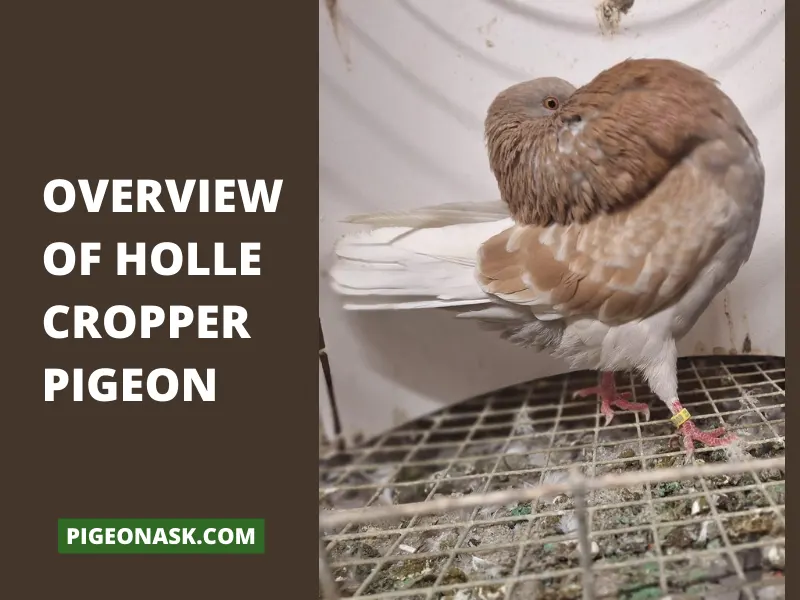
All those names roughly translate to the Balloon Pigeon or Puffer from Amsterdam. The pigeon’s special pouting abilities contribute to such naming.
They have a large, round globe in their chest, which inflates with muscular contraction. At those times, the bird looked like a feathery ball with two legs.
Pigeon fanciers find the gaping or pouting ability of the Holle Cropper very appealing. It also has other desirable traits that make it a fancy pigeon. For instance, a prominent forehead, an S-shaped neck, pied or tiger splash colors, etc.
All of these make this bird an excellent exhibit in pigeon shows. Holle Cropper Pigeons don’t require keen maintenance. They are hardy birds and can survive tough conditions.
However, you must provide basic pigeon care if you want the birds to live long and breed well. A quality Holle Cropper can sell for $350 or upwards.
History And Origins of Holle Cropper Pigeons
The Holle Cropper Pigeons originated in Amsterdam, Netherlands. They are one of the oldest fancy pigeon breeds in recorded History. You can find Dutch paintings as old as the 16th century that show these pigeons.
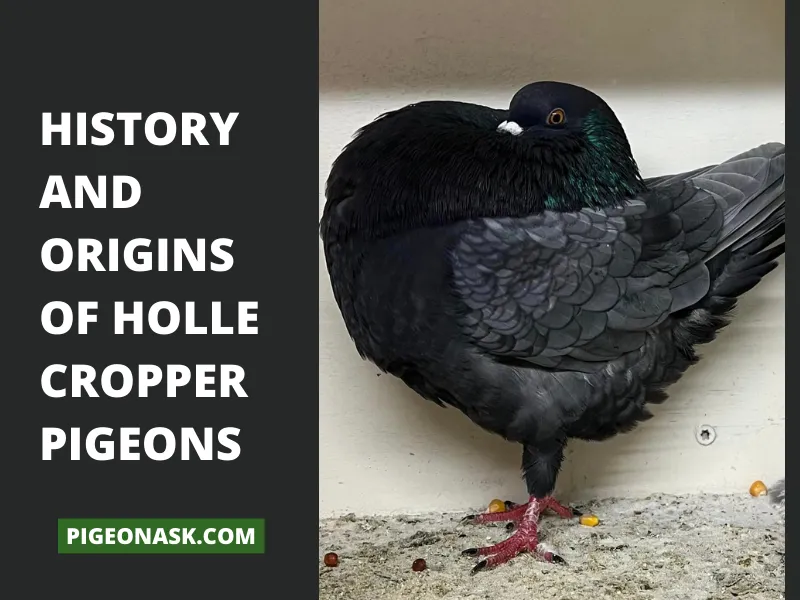
Like other domesticated pigeons, the Holle Cropper tracks its origin back to the Rock Dove. Breed-wise, it’s a pygmy pouter.
Today’s Holle Cropper Pigeon is slightly different from the original Amsterdam pouter. Farmers from the USA and other countries have selectively bred these pigeons for many years.
The result is a more symmetrical and vigorous pigeon with fascinating colors.
Physical Characteristics And Features
The Holle Cropper pigeon’s demand is primarily because of its physical features. Pigeon breeders have carefully worked to achieve a perfectly ball-shaped bird.
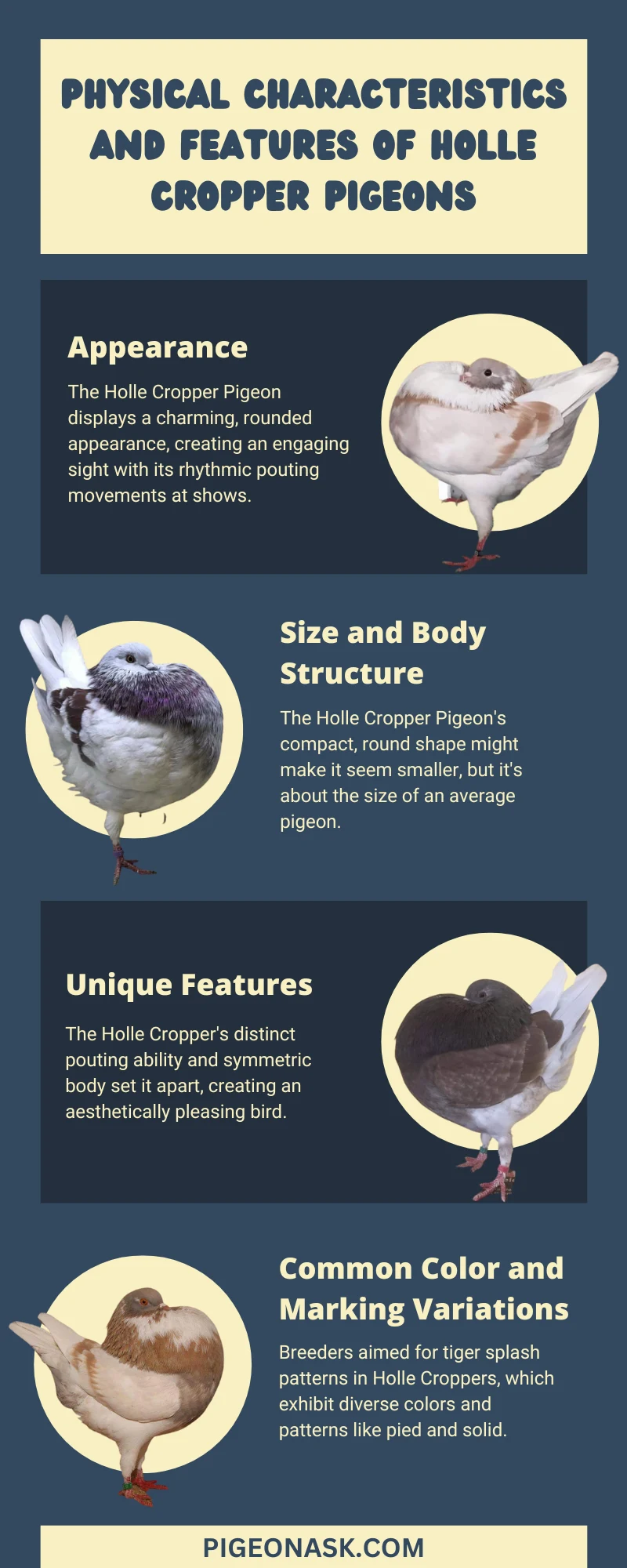
Appearance
The Holle Cropper Pigeon appears pleasingly circular and compact. When pouting, the bird resembles a balloon or ball rhythmically inflating and falling back.
It’s an extraordinary scene and draws a large audience to pigeon shows. The pigeon has a prominent forehead, bright eyes, and a flexible S-shaped neck.
Size and Body Structure
The Holle Cropper Pigeon might appear smaller than the average pigeon due to its stout, rounded appearance. However, they are roughly the same size as an ordinary pigeon. Plus, at 380g, they are heavier than the average pigeon.
Unique Features
Its pouting or gaping abilities are one of the most significant features of this bird.
Most pouters don’t have such aesthetically perfect inflating globes. Their wings and tail are close fit and proportionate to the body. And their small and properly parallel feet contribute to their overall symmetry.
Common Color and Marking Variations
Selective breeders focused on tiger splash colors when developing the Holle Cropper. These pigeons have a base color (white or brown) with stripes. Other variations include Self-colored pigeons, which are a single solid color.
There are also pied Holle Cropper. They have patches on a base color.
Distribution And Habitat
The Holle Cropper Pigeon has been in the Netherlands since the 16th century. However, it is not exclusive to the region anymore. The bird’s unique features attracted a lot of enthusiasts who helped in the global adoption of the breed.
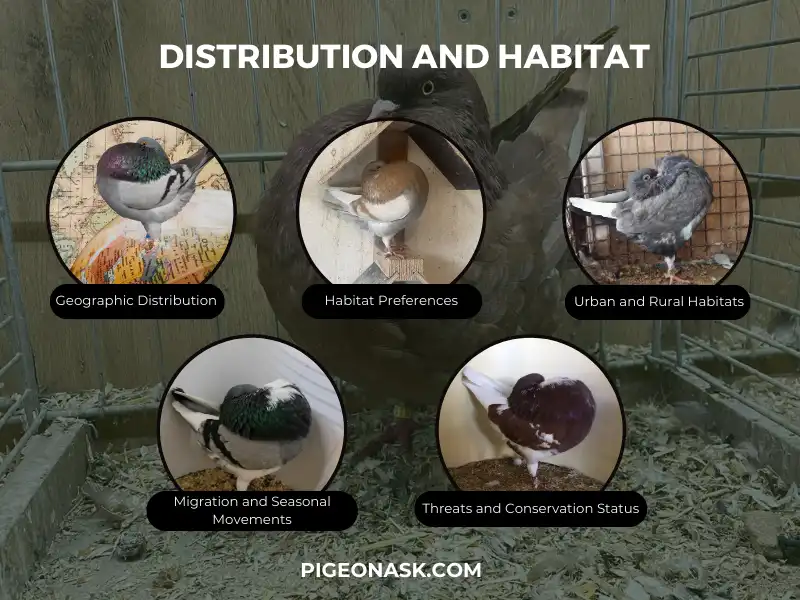
Geographic Distribution
Being a bird of robust health, the Holle Cropper has survived in different areas of the world, although it is primarily a European pigeon breed.
Apart from Amsterdam, the bird is also widely adored in Germany, France, Italy, Russia, the USA, and other countries.
Habitat Preference
The Holle Cropper is exclusively a domestic breed. So, it prefers a habitat close to humans.
A breeder should provide the pigeon with a clean, spacious, and well-lit loft with one nest box per pair. Their lofts must have a proper number of feeders and waterers.
Urban and Rural Habitats
The breed can adapt to urban and rural habitats. In the urban setting, a rooftop loft can be their perfect habitat. However, excess noise and pollution can hurt their lifespan and breeding ability.
Their lofts might be in gardens or near the ground in rural areas. So, breeders have to be cautious about predators.
Migration and Seasonal Movements
The Holle Cropper isn’t a wild bird and, therefore, has no migratory instinct. They will stay with their humans all year round. Also, these are not long-distance flyers.
Threats and Conservation Status
These pigeons aren’t necessarily endangered since people adore and professionally breed them. However, they are a fancy breed. So, you can’t expect them to be common, like the feral pigeon.
Behavior And Traits of Holle Cropper Pigeons
The Holle Cropper Pigeon is a friendly bird and likes human company. They aren’t aggressive towards other birds. However, that doesn’t mean they are timid or lack confidence.
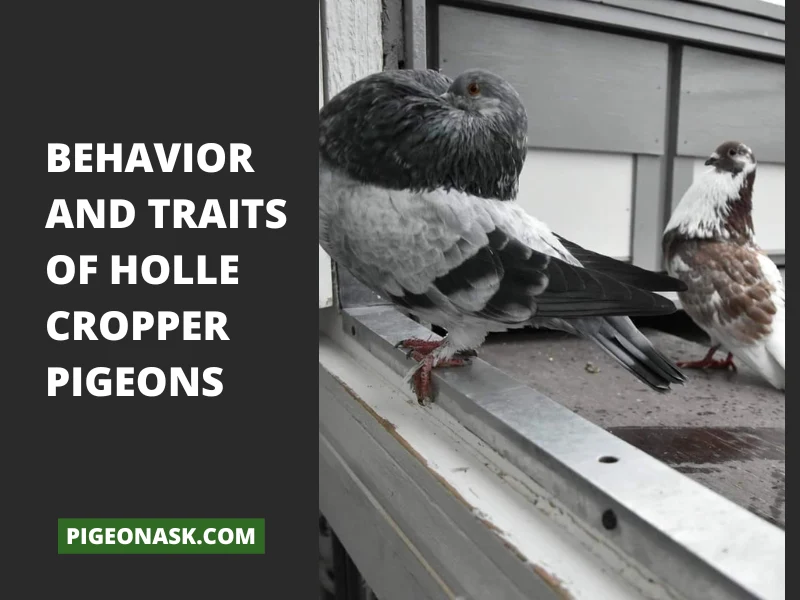
Common Personality Traits
Gaping or Pouting is the most interesting personality trait of these birds. They would inflate their globes when something drives them emotionally. The gaping also has much to do with attracting mates, asserting dominance, and scaring off predators.
Difference between Wild and Domesticated Pigeons
Most wild and feral pigeons are aggressive. They are likely to attack you and steal food. In comparison, the Holle Cropper is calm and gentle. This trait makes them safe for children and other birds.
Diet
These pigeons don’t have any special dietary requirements. They follow a standard pigeon diet rich in seeds, grains, and greens. Fresh water and grit help the pigeon with digestion.
Temperament
The Holle Cropper is a docile bird and doesn’t make a lot of noise. However, they are also very proud of their wonderful inflating globes and love to display them. They strut around confidently while their graceful necks sway with each pace.
Flight
The Holle Cropper Pigeon doesn’t have a remarkable flying ability. They are average flyers. You can’t expect the bird to fly long distances like racing pigeons.
Unlike feral pigeons, they also don’t fly away when taken outside the loft or cage. They tend to carry their head upright in flight instead of extending it to the front.
Nesting, Breeding, and Courtship
During breeding, the Holle Cropper couple will build a nest in the box out of feathers and straws. The pair mates for life, and both parents care for their hatchlings. They usually attract mates by pouting and strutting around.
Lifespan
Pouters and cropper pigeons usually live up to 7-10 years. However, with optimum maintenance (habitat, diet, vaccination), they might survive up to 15 years.
Homing Instinct
The Holle Cropper Pigeons weren’t bred for messengering or racing. Therefore, the breed never developed any strong homing instinct.
They don’t wander far away from home, and if you release them elsewhere, they are unlikely to return. However, with proper training, you might be able to develop the instinct.
Breeding And Maintenance of Holle Cropper Pigeons
To grow beautiful ball-shaped- Holle Croppers, you must provide them with a proper home, food, and breeding environment. They are strong birds that adapt to harsh conditions. Still, they are sensitive to parasites, darkness, and cold.
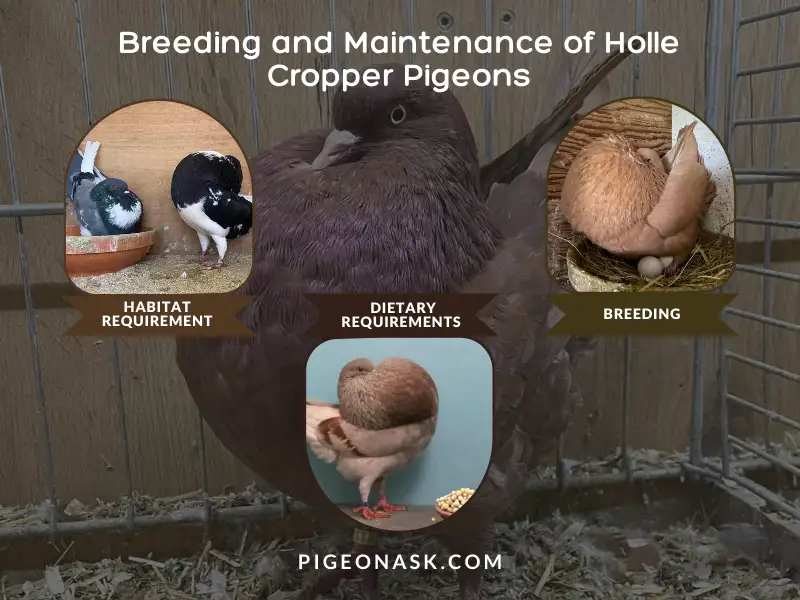
Habitat Requirement of the Holle Cropper Pigeon
You can build a two-metre-high loft for your Holle Cropper Pigeons. Usually, 0.5 square meters is adequate floor space for each bird. Plus, they need around ten cubic feet of flying space. You can consider these two factors and adjust the width of your loft according to the number of pigeons.
The habitat should be clean, well-ventilated, and permit much natural light. It should provide adequate shelter to the pigeons during extreme weather conditions.
Cover the floor in a layer of straw or wood shavings and change it weekly. This will ensure proper hygiene and dryness. Provide one nest box for each pigeon pair. The loft must have adequate perches, waterers, and feed boxes. You must routinely clean these, too, to keep the pigeons free from diseases.
There should be windows and a skylight to permit sunlight entry. During the winters, use an artificial light to warm the loft. Don’t let the loft get too hot or warm. Try to always maintain a temperature between 65-70F in your pigeons’ home.
In the urban area, raccoons, cats, and rats are the undesired company for your pigeons. And the range of potential predators increases when you are raising the birds in a rural setting.
To prevent unwanted entry, use wire meshes for the windows. You can landscape the outside of the loft with metal thorns. Motion detectors coupled with light and sound emitters can help fend off predators at night.
Avoid overcrowding to prevent the spread of disease. Raising larger aggressive breeds with the small and docile Holle Cropper Pigeon is also unwise.
Dietary Requirements of the Holle Cropper Pigeon
These pigeons can develop fine on standard pigeon food. Of course, you would want to provide the highest quality diet for the best results. The Holle Cropper Pigeon requires a healthy mix of seeds, grains, and veggies regularly.
You can follow an evening-morning routine to feed the pigeons. Wheat, barley, and oats are some excellent grains for them. High-quality millet and sunflower seeds can supply the nutrients the pigeons need for proper development.
Lettuce, spinach, and parsley are loaded with carotenoids, boosting the Holle Cropper’s feather colors. They also eat pears and apples.
Besides these items, grit helps in their digestion. Crashed oyster shells in the grit can help fulfill their calcium needs.
Some owners are in the habit of feeding their birds leftovers. For instance, pizza crumbs or old bread. Others might lovingly treat their birds to sugary treats.
Although feral pigeons can thrive on such diets, it is not recommended for fancy breeds like the Holle Cropper. Processed ingredients in human food can cause obesity, poor feather quality, and other negative impacts on the pigeon.
Breeding Holle Cropper Pigeons
Usually, the Holle Cropper lays eggs four times a year. However, you might get 5-6 breeds with the best maintenance. There might be one or two eggs in each clutch.
For the best result, you should start with a pair of Holle Croppers with the desired physical features.
A spacious loft and comfortable nest box encourage these pigeons to breed. The pair needs a proper environment to display their inflating globes and strut around.
Meanwhile, a proper diet ensures better egg health and the hatching of healthy offspring.
Both pigeon parents participate in raising the hatchlings. The incubation period is for eighteen days. the parents feed their young exclusively on crop milk for the first few weeks. Gradually, they start feeding them seeds and other food.
Final Words
Raising Holle Cropper Pigeons can be very rewarding. You can choose to become a professional breeder or just keep a pair of exotic pets. Either way, these beautiful puffers can make all the maintenance efforts worthwhile.
You should follow a vaccination schedule to keep your pigeons free from possible diseases. Most importantly, these birds crave human companionship. So, take some time to interact with the pigeons every day.
That’s all for this discussion. If you liked the article, share it with pigeon fanciers raising Holle Croppers. For similar content in the future, follow us on Facebook, X, and Google News.
